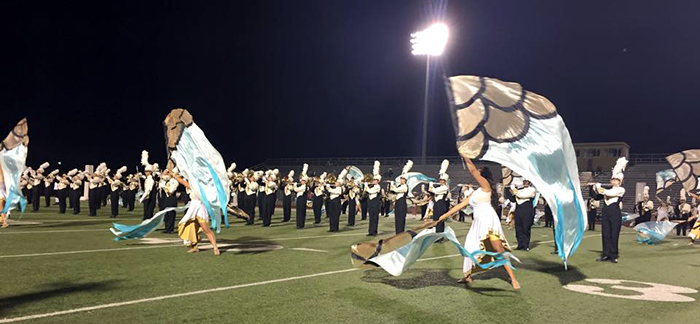
Poof! Through some twist of fate, you’re suddenly in charge of a color guard. Soon the panic sets in. You experience self-doubt as you have no prior experience, or so you think.
Managing a color guard is much like managing any other student organization. Classroom management, attention to detail, and expectations are all things that are part of a sound teaching environment. Here are a few tips to help you on your way to successful guard program.
Use Your Experience as a Band Director
You will want to implement procedures and expectations both on and off the field. Even grading can be done with pass-offs, performance requirements and videos just like our kids do with SmartMusic for winds and percussion.
“As someone who wears both hats, I just take the concepts I use as a band director and implement them with the color guard. Daily Drill = Equipment/movement fundamentals. Find the parallel concepts and go from there one step at a time.”
– Johnnie Green, assistant band director and guard director at Lehman High School, Kyle, TX
Reach Out
There are winterguard circuits nationally that you can reach out to for more information. Many circuits offer training for instructors and students with spin camps and clinics. Most circuits have two meetings a year. You could attend and network with other area instructors. Most circuits also have a social media presence that you can tap into for advice, flags and costumes for sale, and any questions you may have.
There are also mentor programs you can check into. Most instructors are also willing to help, even offer friendly advice. Help is literally an email away. Use your state’s band association site for networking. Most have job boards and social resources available to connect with other instructors.
Lastly, the internet is a HUGE resource. Use YouTube to search for guard choreography and you’ll have an ocean of videos to resource from. Beware, you will encounter the good, the bad, and the ugly, so use your best judgement.
Hire Help If You Can
If you have the opportunity to do so, enlist some on-the-field assistance.
“Hire a choreographer, tech or assistant director/teacher that has a color guard background.” There is nothing better than having daily access to someone who has the knowledge and skill to instruct a guard program. Think of it in the band perspective: Would you just let anyone teach your beginner horns? Much like budding musicians, beginner guard students are learning how to walk in time, while spinning a piece of equipment, and performing at the same time. This is not easy for just anyone to teach. A skilled assistant will make life easier for you and your students.
– Michael Vazquez, director of ATX Independent Winterguard
Resources
WGI.org has a wonderful catalog of educational DVDs that focus on various topics such as training for dance, flag, rifle, sabre, as well as how to design. From time to time, clinics and camps are offered through WGI SPIN or MUSIC FOR ALL (BOA). These camps are great to connect with other designers and teachers. Again, reach out!
You might also seek help from a dance studio in your area or from your school’s dance teacher. “No dazzling equipment work will make up for poor posture and lack of core strength,” says retired director Sue Cechel. All color guard design and fundamentals are are built upon a basic dance foundation. Ballet fundamentals are an excellent start for any budding program as all competitive guard have a movement class built into their programs. Have your dance teacher design a warm-up routine that covers basic movements and do it daily.
Guard Kids are Band Kids, Too
“There are two kinds of band directors. The first views the guard as an integral part of the drill and the music. The second views the guard as merely ‘backup singers’ who keep the beat and stay out of the way. I want the guard to be the visual representation of the show you wish to produce. Please make them a section of the band, the visual section, as that will lend itself toward a more cohesive performance.”
– Sue Cechal, guard director in Manitowoc, WI
I have been there. My high school program did not have a dedicated guard teacher and we were left on our own. As you would expect, high school drama and teenage emotions played and got in the way of the real work. In turn, our band directors did not value us as equals on the field. It made for a miserable high school experience.
“Don’t think that color guard is just flapping some flags around on the field and anyone can teach it. That only leads to disappointment and heartbreak”
– Jackie Krasuski, Spintronics Director
To put it simply, you would not leave your flutes to learn the opener of the marching program all alone. Why would you let any group of students, no matter how big or small, work on their own. When students are without supervision and care, negative things happen. You don’t have to know a drop spin from a second position, but you should be there to manage the class.
For example, I include the color guard in all aspects of the marching band. Warm up everybody with the band and marching fundamentals. Sure, we march toe down and the winds and percussion march toe up, but foot timing, articulation of the feet, facing, awareness of space and projection are all things every member of the band works on. I then split to warm up hands while they playing exercises.
We come together to rehearse. One Band, One Vision, One Sound, One Score. You’ll find that there are many things that musicians and your visual ensemble have in common the more you work with them.
Know What You Have and Don’t Have
You may have girl that can tumble in your guard. You may have a boy that can do a toss and turn underneath and catch. Look for the hidden gems in your program and highlight them.
On the flip side, don’t expect a group of first year spinners to do the same choreography that you see Onyx or Santa Clara Vanguard do. Take the time to train, build a foundation of sound fundamentals, and develop strong performers throughout the season.
Color guard is a wonderful activity. It takes a little time, patience, and love for the students you’ll be working with daily. You can establish and develop a strong program that can complement your band program.
 Heather Benton is a graduate of the University of Miami where she performed in their “Band of the Hour” Color Guard. She has also performed with Alliance of Miami and Echos of New Orleans Parade Corps and has designed for many programs in Texas, Louisiana and Florida. She was tour manager then tour director for the Blue Knights Drum & Bugle Corps and currently serves as board president of Invictus World.
Heather Benton is a graduate of the University of Miami where she performed in their “Band of the Hour” Color Guard. She has also performed with Alliance of Miami and Echos of New Orleans Parade Corps and has designed for many programs in Texas, Louisiana and Florida. She was tour manager then tour director for the Blue Knights Drum & Bugle Corps and currently serves as board president of Invictus World.
Heather is a member of the Texas Color Guard Judges Association,Texas Bandmasters Association and Texas Music Educators Association. She currently resides in New Braunfels, TX and has been the Seguin HS Color Guard Director and band secretary since 2011.